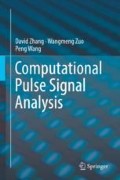Abstract
This chapter proposes a novel approach to the detection of arrhythmic pulses using the Lempel-Ziv complexity analysis. Four parameters, one lemma, and two rules, which are the results of heuristic approach, are presented. This approach is applied on 140 clinic pulses for detecting 7 pulse patterns, not only achieving a recognition accuracy of 97.1% as assessed by experts in TCM but also correctly extracting the periodical unit of the intermittent pulse.
Access this chapter
Tax calculation will be finalised at checkout
Purchases are for personal use only
References
L. I. Hammer, Chinese Pulse Diagnosis: A Contemporary Approach, Eastland Press, Vista, Calif, USA, 2001.
J. H. Laub, “New non-invasive pulse wave recording instrument for the acupuncture clinic,” American Journal of Acupuncture, vol. 11, no. 3, pp. 255–258, 1983.
B. Michael and M. Michael, “Instrument-assisted pulse evaluation in acupuncture, ” American Journal of Acupuncture, vol. 14, no. 3, pp. 255–259, 1986.
H. Seng, “Objectifying of pulse-taking,” Japanese Journal of Oriental Medicine, vol. 27, no. 4, p. 7, 1977.
K.-Q. Wang, L.-S. Xu, Z. Li, D. Zhang, N. Li, and S. Wang, “Approximate entropy based pulse variability analysis,” in Proceedings of 16th IEEE Symposium on Computer-Based Medical Systems (CBMS ‘03), pp. 236–241, New York, NY, USA, June 2003.
W. K. Wang, T. L. Hsu, Y. Chiang, and Y. Y. Lin Wang, “Study on the pulse spectrum change before deep sleep and its possible relation to EEG, ” Chinese Journal of Medical and Biological Engineering, vol. 12, pp. 107–115, 1992.
L. Y. Wei and P. Chow, “Frequency distribution of human pulse spectra, ” IEEE Transactions on Biomedical Engineering, vol. 32, no. 3, pp. 245–246, 1985.
H.-L. Lee, S. J. Suzuki, Y. Adachi, and M. Umeno, “Fuzzy theory in traditional Chinese pulse diagnosis,” in Proceedings of International Joint Conference on Neural Networks (IJCNN ‘93), vol. 1, pp. 774–777, Nagoya, Japan, October 1993.
Y.-Z. Yoon, M.-H. Lee, and K.-S. Soh, “Pulse type classification by varying contact pressure,” IEEE Engineering in Medicine and Biology Magazine, vol. 19, no. 6, pp. 106–110, 2000.
G. K. Stockman, L. N. Kanal, and M. C. Kyle, “Structural pattern recognition of Carotid pulse waves using a general waveform parsing system, ” Communications of the ACM, vol. 19, no. 12, pp. 688–695, 1976.
L. Wang, K.-Q. Wang, and L.-S. Xu, “Recognizing wrist pulse waveforms with improved dynamic time warping algorithm, ” in Proceedings of the 3rd International Conference on Machine Learning and Cybernetics (ICMLC ‘04), vol. 6, pp. 3644–3649, Shanghai, China, August 2004.
B. H. Wang and J. L. Xiang, “ANN recognition of TCM pulse states, ” Journal of Northwestern Polytechnic University, vol. 20, no. 3, pp. 454–457, 2002.
S. L. Huang and M. Y. Sun, The Study of Chinese Pulse Image, Chinese People’s Sanitation Press, Beijing, China, 1995.
L. S. Zhen, Pulse Diagnosis, Paradigm Publications, Brookline, Mass, USA, 1985.
A. Lempel and J. Ziv, “On the complexity of finite sequences,” IEEE Transactions on Information Theory, vol. 22, no. 1, pp. 75–81, 1976.
J. Ziv, “Coding theorems for individual sequences, ” IEEE Transactions on Information Theory, vol. 24, no. 4, pp. 405–412, 1978.
R. Nagarajan, “Quantifying physiological data with Lempel-Ziv complexity-certain issues,” IEEE Transactions on Biomedical Engineering, vol. 49, no. 11, pp. 1371–1373, 2002.
L. Y. Huang, Q. X. Sun, and J. Z. Cheng, “Novel method of fast automated discrimination of sleep stages,” in Proceedings of the 25th Annual International Conference of the IEEE Engineering in Medicine and Biology Society, vol. 3, pp. 2273–2276, Cancun, Mexico, September 2003.
X.-S. Zhang, R. J. Roy, and E. W. Jensen, “EEG complexity as a measure of depth of anesthesia for patients,” IEEE Transacions on Biomedical Engineering, vol. 48, no. 12, pp. 1424–1433, 2001.
S. Mund, “Ziv-Lempel complexity for periodic sequences and its cryptographic application,” in Advances in Cryptology— EUROCRYPT ‘91, pp. 114–126, Brighton, UK, April 1991.
K.Q. Wang, L.S. Xu, L. Wang, Z. G. Li, and Y. Z. Li, “Pulse baseline wander removal using wavelet approximation,” in Proceedings of the 30th Annual Conference of Computers in Cardiology (CinC ‘03), pp. 605–608, Thessaloniki, Chalkidiki, Greece, September 2003.
M. A. Navakatikyan, C. J. Barrett, G. A. Head, J. H. Ricketts, and S. C. Malpas, “A real-time algorithm for the quantification of blood pressure waveforms,” IEEE Transactions on Biomedical Engineering, vol. 49, no. 7, pp. 662–670, 2002.
G. Gratze, J. Fortin, A. Holler, et al., “A software package for non-invasive, real-time beat-to-beat monitoring of stroke volume, blood pressure, total peripheral resistance and for assessment of autonomic function, ” Computers in Biology and Medicine, vol. 28, no. 2, pp. 121–142, 1998.
K. G. Belani, J. J. Buckley, and M. O. Poliac, “Accuracy of radial artery blood pressure determination with the Vasotrac, ” Canadian Journal of Anesthesia, vol. 46, no. 5, pp. 488–496, 1999.
L.-S. Xu, D. Zhang, and K.-Q. Wang, “Wavelet-based cascaded adaptive filter for removing baseline drift in pulse waveforms, ” IEEE Transactions on Biomedical Engineering, vol. 52, no. 11, pp. 1973–1975, 2005.
D. Gusfield and J. Stoye, “Linear time algorithms for finding and representing all the tandem repeats in a string, ” Journal of Computer and System Sciences, vol. 69, no. 4, pp. 525–546, 2004.
Author information
Authors and Affiliations
Rights and permissions
Copyright information
© 2018 Springer Nature Singapore Pte Ltd.
About this chapter
Cite this chapter
Zhang, D., Zuo, W., Wang, P. (2018). Arrhythmic Pulse Detection. In: Computational Pulse Signal Analysis. Springer, Singapore. https://doi.org/10.1007/978-981-10-4044-3_7
Download citation
DOI: https://doi.org/10.1007/978-981-10-4044-3_7
Published:
Publisher Name: Springer, Singapore
Print ISBN: 978-981-10-4043-6
Online ISBN: 978-981-10-4044-3
eBook Packages: Computer ScienceComputer Science (R0)

